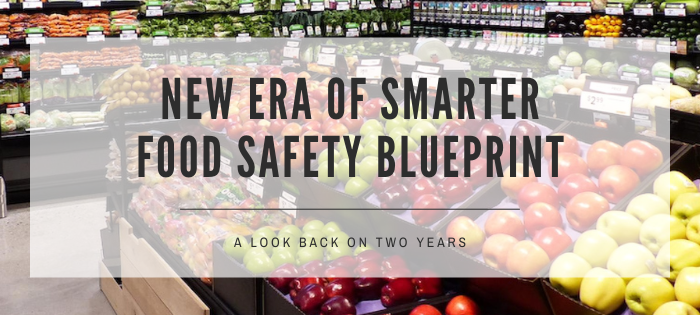
Food Safety
Comments: No Comments
Two years ago—on July 13, 2020—the Food & Drug Administration (FDA) published the New Era of Smarter Food Safety Blueprint, providing the roadmap FDA will follow to further food safety modernization under the Food Safety Modernization Act (FSMA). According to FDA, “Smarter food safety is about more than just technology. It’s also about simpler, more effective, and modern approaches and processes. It’s about leadership, creativity, and culture.”
This has remained the Administration’s focus as it has pushed its New Era of Food Safety forward to meet the Blueprint’s goals to:
- Enhance traceability
- Improve predictive analytics
- Respond more rapidly to outbreaks
- Address new business models
- Reduce contamination of food
- Foster the development of stronger food safety cultures
Progress to Date
For the past two years, FDA has focused on initiatives to support the four core elements identified in the Blueprint. Progress-to-date has included the following:
Core Element #1: Tech-Enabled Traceability. FDA has taken several actions to use technology to create food traceability advancements and reduce foodborne illness:
- The proposed Food Traceability Rule was published on September 23, 2020, as required under FSMA Section 204(d), to enhance traceability recordkeeping for certain identified foods beyond a limited “one-up, one-back” traceback approach. The final rule must be submitted by November 7, 2022.
- Twelve winning teams were selected in FDA’s Low- or No-Cost Tech-Enabled Traceability Challenge, which encouraged development of traceability systems that are cost-effective for food operations of all size. The winning entities are now working with FDA to disseminate their ideas to stakeholders.
Core Element # 2: Smart Tools for Outbreak Response. The Blueprint seeks to strengthen the use of data for root cause analyses and predictive analytics to prevent future outbreaks. Advancements in this area have included the following:
- FDA conducted a pilot study designed to strengthen the ability to predict which shipments of imported seafood pose the greatest risk of violation. Results show that machine learning could increase the likelihood of identifying a shipment containing potentially contaminated products.
- FDA has increased the amount and quality of data through information sharing agreements with regulatory and public health partners, academic institutions, industry, and others. This includes domestic mutual reliance agreements signed with five states (i.e., California, Florida, Minnesota, Utah, and Wisconsin), which “provide opportunities for the FDA and state partners to lay a quality foundation for sharing information and working together on regulatory services and food protection that industry and consumers can trust.”
- In December 2021, FDA released its Foodborne Outbreak Response Improvement Plan, which sets the stage to “enhance the speed, effectiveness, coordination, and communication of foodborne outbreak investigations” through tech-enabled product traceback, root cause investigations, stronger analysis and dissemination of outbreak data, and operational improvements.
Core Element #3: New Business Models and Retail Food Modernization. As FDA has acknowledged, “The COVID-19 pandemic underscores the need for modern approaches as we respond to unique demands on our food system, from unprecedented imbalances in the marketplace, to changing consumer behaviors and a rise in e-commerce, to challenges to performing inspection and compliance work in FDA’s traditional manner.” Correspondingly, the Administration is considering how to address potential food safety vulnerabilities for foods ordered online and delivered directly to the consumer.
Core Element #4: Food Safety Culture. The improvements in food safety, foodborne illness, and outbreaks outlined above depend largely on food safety culture. Every action the FDA takes is intended to help create an atmosphere where organizations are aware of and help to prevent any process and/or operational issues and deviations that may impact the safety and/or quality of their food products. FDA also remains focused on consumer education regarding safe handling of food.
A Look Ahead
As FDA continues to push its New Era of Food Safety forward and new challenges surface, it is important to understand the current landscape, set priorities, and commit the appropriate resources to ensure long-term sustainability. Certainly, the COVID-19 pandemic has heightened a number of issues and unique demands on the food safety system.
As the Blueprint enters year three, FDA will continue to advance its core elements and goals. Companies that operate in the food industry should consider undertaking the following activities to align with FDA’s objectives:
- Implement a food safety compliance management system to help coordinate, organize, control, analyze, and visualize the information necessary to remain in compliance and operate efficiently.
- Conduct third-party assessments to provide an outside perspective of food safety systems and compliance/certification to identify gaps in programs that need development/updates.
- Explore technological advancements that allow for further digitization and promote more timely and accurate collection and management of important data.
- Gather/manage data and conduct root cause analysis, as needed, to identify underlying issues and ensure similar problems do not occur in the future.
- Build a strong food safety culture that focuses on changing from a reactionary to a preventive mindset that promotes safety and quality.
